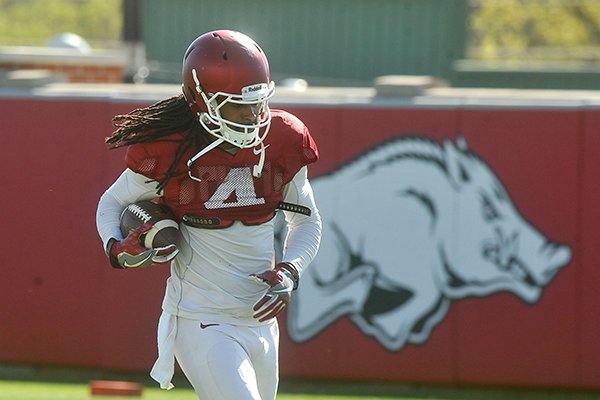FAYETTEVILLE -- The misfortunes of Keon Hatcher, Cody Hollister and Jared Cornelius served as the catalyst that unlocked the full Arkansas offense under first-year coordinator Dan Enos in 2015.
The domino effect from their injuries could trigger a significant change in the Razorbacks' offensive approach this fall.
Wideout production
• Arkansas emerged as one of the more prolific passing teams in the country under first-year offensive coordinator Dan Enos in 2015. A look at the statistics for the Hogs’ top returning receivers, plus tight end Jeremy Sprinkle
Player;Rec-Yds-TDs;YPC;Note
Drew Morgan;63-843-10;13.4;TD catches tied for 2nd in the SEC
Dominique Reed;28-535-6;19.1;Second in SEC yards per catch
Jeremy Sprinkle;27-389-6;14.4;Led SEC, tied for 8th in NCAA TDs by TEs
Jared Cornelius24-393-3;16.4;Also scored 2 rushing TDs, returned punts
Keon Hatcher;13-198-2;15.2;Compiled all his stats in two games
Damon Mitchell;6-84-1;14.0;Now in the tailback rotation
Cody Hollister;4-65-0;16.2;Limited to eight games with foot injury
Hatcher, Hollister and Cornelius missed a combined 23 games a year ago because of injuries for a receiving group that was projected as a huge question mark going into the season. Instead of lapsing into imbalance behind the nation's largest offensive line and 1,500-yard rusher Alex Collins, the Arkansas offense thrived through the air and on the ground.
The rise of wideouts Drew Morgan and Dominique Reed to complement tight ends Hunter Henry and Jeremy Sprinkle as quarterback Brandon Allen's top targets forced defenses to honor the run and pass. The Hogs finished No. 29 in total offense and a No. 5 in passing efficiency.
Cornelius' return from a broken arm for the Razorbacks' 63-28 victory over Tennessee-Martin after missing four games strengthened the group during Arkansas' 6-1 finish.
"I think last year what happened to the wideouts wasn't necessarily a great thing because guys went down, but it definitely helped us," said Morgan, who underwent shoulder surgery after the season and has not participated in contact work this spring. "Only because we had to put younger guys in and the younger guys, including me, had to step up and play."
Hatcher, who is back for his senior season, said he wasn't worried about the receivers behind him after he suffered a broken foot Sept. 12.
"We were deep last year, but we actually got to show you guys that," he said. "B.A. was stepping back and throwing the ball around, and we were out there making plays. We expect the same thing this year."
Each one of those players is back, with the exception of Henry, to help the revamped offense headed by junior quarterback Austin Allen.
Coach Bret Bielema signaled the strength of the receivers Saturday by suggesting Arkansas might change its base look.
"This might be the first time our best personnel might be three to four wide receivers on the field at a time for certain situations," Bielema said. "I know Dan wanted to experiment with that [four wide] look. And our defense definitely needs to get a lot of that look that we saw, obviously, from our competition within our league."
Ole Miss, Mississippi State, Texas A&M and others make frequent use of multiple receivers and -- because the tight ends behind Sprinkle have not showed consistency this spring -- Arkansas might trend further in that direction.
"I definitely see that developing," said receivers coach Michael Smith, who got a significant pay raise after the big season from his receivers and a job offer from LSU over the winter. "What I always told people, I always thought I had really good wide receivers, but we always had two really good tight ends and two really good running backs.
"In order to get the ball to all those playmakers, somebody's position had to sit in the background. We did that for two years I believe, and now we've been thrust to the forefront because of guys making decision to go and play at the next level. We're up for the challenge."
Enos testified to the strength of the receivers Tuesday.
"The receivers are one group that's way ahead," he said. "I told them ... during stretch that I used to walk down there and just wonder what they were going to do today. Now I walk down there and look at them and I'm like, 'These guys are solid.' They've had a really good spring."
Hatcher joins Morgan, Reed and Hollister to give the Razorbacks four experienced seniors. Cornelius heads up the junior class of wideouts.
Hatcher and Morgan will battle at one spot, Reed and Hollister head the depth at the other receiver position, and Cornelius leads the group of slot receivers, which includes redshirt freshman Deon Stewart, who Smith described as the team's sixth receiver.
"The thing that has been really, really encouraging about this group is that these guys are all interchangeable," Smith said. "We can play them all at every position on the field. It's been a process, a lot of work these guys have put in in the classroom to get know this offense and be able to go out and execute it."
Reed, who scored touchdowns in six consecutive games, starting with Arkansas' 24-20 victory at Tennessee on Oct. 3, is trying to add weight to his 6-3, 175-pound frame, but he's struggling.
"Man, I eat all the time," Reed said. "All the time. That's the point. It's just, I don't know what it is. I'm still trying to figure it out myself."
Reed said he'd like to be stronger in his upper body to help with separating from pressing defensive backs and in blocking.
"It's just about being more physical, being big," he said.
Late last season, Smith wondered how there would be enough footballs to feed all the playmakers in the Arkansas receiving corps. The Razorbacks hope to find that out with their new-look offense in the fall.
"I feel like with the competition that we're bringing to the table, it's going to be very hard for the DBs in the SEC this season," Morgan said.
Sports on 04/21/2016

